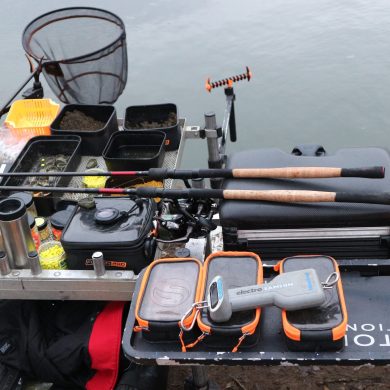Part of the challenge has been finding a vessel that can travel offshore 100 miles to search possible spawning areas for tarpon. We were recently very fortunate that Chris Fischer of Fischer Productions and the conservation foundation OCEARCH, generously donated the use of his vessel, the M/V Ocean, for an offshore trip to search for spawning tarpon.
A generous offshore fisherman based in Boca Grande, FL, had previously given BTT coordinates for a potential spawning location. This fisherman has witnessed multiple times what appears to be spawning tarpon near the full and new moons; thousands of fish on the surface bumping and rubbing, and noticeably milky water. With this information in hand, a group of scientists boarded the M/V Ocean on the morning of July 1, and departed Boca Grande Pass for a three day trip with only one mission on this new moon of July: find spawning tarpon. On the 12 hour trip to our waypoint, conditions looked promising with flat calm seas, cloudy skies and plenty of Atlantic thread herring and menhaden to eat. Everyone on board scouted (some with binoculars) for signs of rolling tarpon or any heavy commotion at the surface. We reached our coordinates at sunset on the eve of the new moon, but there was no activity at the surface – no tarpon, no baitfish.
Two graduate students from the Florida Institute of Technology were onboard to sample plankton by pulling two types of nets, one for surface and one at 10’ depth, with fine mesh with the hope of finding tarpon eggs and young larvae. Once at the waypoint, the students pulled the surface plankton net twice – for 20 minutes each – followed by two 20 minute pulls of the net at 10’ depth. Each pull produced multiple eggs from approximately 7 species of fishes. Lab analyses to determine the exact species are still under way. The plankton nets were pulled at morning and dusk each day over the three day trip, four pulls each time (2 surface, 2 subsurface) at 20 minutes for a total number of 16 pulls on the trip. Water temperatures averaged 85°F and salinity was 37% – perfect for spawning tarpon.
After the first series of plankton pulls, we decided to drift since the new moon prohibited any type of scouting. The next morning, after dodging thunderstorms, Captain took the boat along a north-south search pattern (10 miles in each direction), using the coordinates as a center point. Researchers were on deck scanning the water for signs of tarpon, but without a single tarpon sighting. At the end of Day 2, we ended the search at our waypoint and ran the third series of plankton pulls. Our position coincided with a weedline which resulted in much Sargassum algae in the net along with its inhabitants including crabs and filefish.
On the morning of Day 3, the last series of plankton nets were pulled, and after searching the area for signs of tarpon, we began the long journey home. Throughout the voyage home, all hands on deck scouted the horizon for signs of tarpon, but again to no avail. We arrived at the Boca Grande channel around 9:00pm on the 3rd of July to a welcoming committee of fireworks from three counties.
Although this offshore trip was not successful in finding tarpon spawning offshore, persistence is key. For example, BTT continues to fund satellite tags for tarpon in the spring with the focus of finding where these fish go to spawn. And offshore searches will likely occur again in the future. Once spawning locations are found, BTT will then work toward ensuring these locations are protected so that successful spawning continues to occur, ensuring future generations of tarpon.
Please consider supporting the work of the Bonefish & Tarpon Trust, especially if you enjoy fishing for these species.

